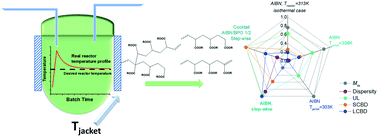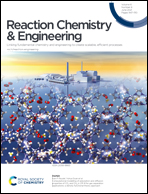Jacket temperature regulation allowing well-defined non-adiabatic lab-scale solution free radical polymerization of acrylates†
Abstract
Conventional batch solution free radical polymerization (FRP) of n-butyl acrylate (nBuA) with thermal initiators such as 2,2′-azobis(2-methylpropionitrile) (AIBN) is known to be strongly exothermic and influenced by highly activated side reactions such as backbiting and β-scission. However, most FRP kinetic modeling studies are focusing on simplified (theoretical) isothermal conditions and/or are considering only ball-park values for the Arrhenius parameters. In the present work, we overcome these limitations by combining a detailed tree-based kinetic Monte Carlo (kMC) model for radical acrylate polymerization chemistry with an energy balance so that non-isothermal conditions (targeted temperature in range 313–353 K) can be modeled in the presence and absence of jacket temperature modifications. As the reactor size is limited and solution conditions are selected perfect macro-mixing can be assumed but at the micro-scale chain length dependent diffusional limitations on termination need to be accounted for. The inputted Arrhenius parameters all stem from independent experimental techniques (e.g. stepwise pulsed laser polymerization) and the only tuned parameter is the global heat transfer coefficient as determined from a Pyrex 2 L lab-scale reactor. We highlight the relevance of our Arrhenius parameters to reliably predict non-isothermal reactor conditions and demonstrate that safe reactor operation conditions can only be realized by design of the jacket temperature. We utilize both flat profiles and stepwise profiles, including variations in (i) the number of steps and (ii) upward and downward temperature changes. We also put forward that the heat generation rate can be designed by varying the thermal initiator type and considering thermal initiator cocktails. In the end, we tune the batch time, the log-molar mass distribution (MMD) differentiating between unimodal and bimodal shapes, MMD dispersity, unsaturation level, and short/long chain branching density employing industrially relevant conditions. Such conditions lead to a safe reactor operation but remain non-adiabatic, highlighting the future need of non-isothermal polymer reaction engineering models.



 Please wait while we load your content...
Please wait while we load your content...